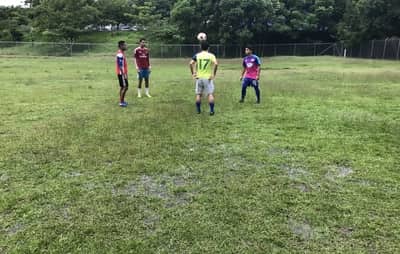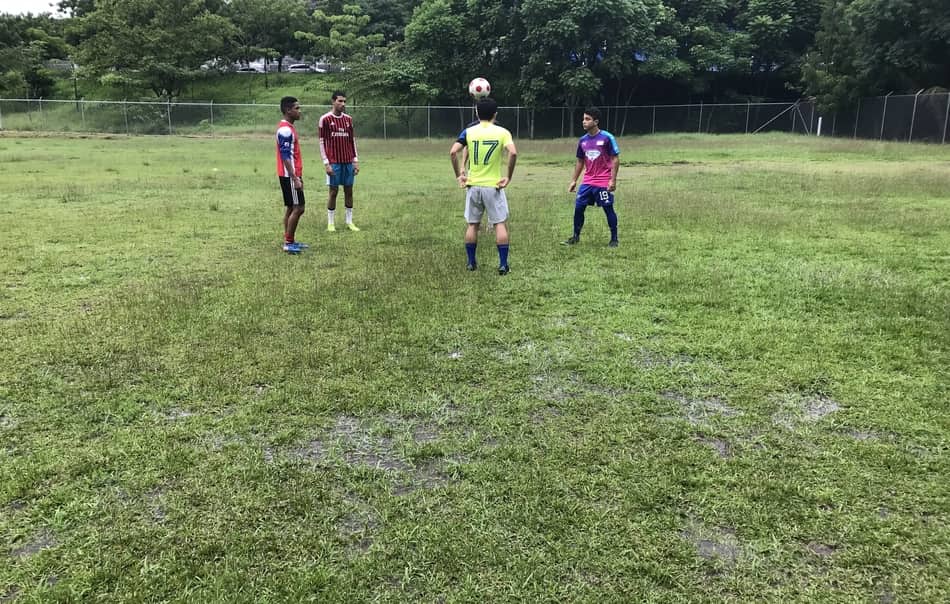
I am from Panama, a country where it rains about 9 months during the year. Rain is something super normal in here, and something everyone has to adapt to, including us, the soccer players.
Unlike other indoor sports like Basketball, indoor soccer, volleyball, and others, a soccer game’s conditions can be seriously affected by climate conditions such as: heat, wind, rain, snow, etc. A soccer game will not stop unless there is lightning or other natural disaster alert near by. A good soccer player needs to adapt to the different climate conditions and be intelligent making them play to his favor.
Playing in the rain always causes a big debate among soccer players. Some say they absolutely hate it while others say it is more fun to play in this conditions.
Even big pro clubs have their own preferences regarding the dryness of the pitch. Some like playing on more wet playing surfaces, so the ball moves faster, and to have a more fluent game. These teams water the field before every game and during halftime. While other clubs like a little bit dryer field.
Last week I was at soccer practice with my college soccer team when a storm came. We had to keep practicing because our first game of the season was very close. That day I contrast the big difference between playing in a nice dry field with a totally wet one.
I remember thinking about so many thing I could’ve done that day during and after the practice (tips that I am going to share with you today). I also had to change my game and try new techniques to better perform in this type of weather condition. I’m pretty sure that the next time I play in the rain, I’ll perform even better than I did that day, and so will you if you put in practice this 16 tricks to play soccer in the rain.
More pace to the ball
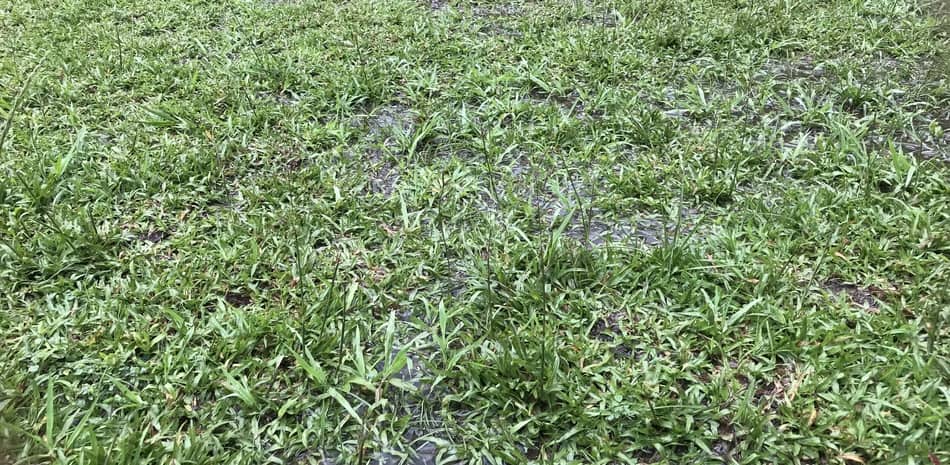
When it rains too much, the field gets to a point where it can’t absorb more water, causing the so hated puddles to appear. These puddles usually slow the speed of the ball, making that pass that you imagined on a dry pitch, not to be a reality on the wet pitch.
When you are going to pass the ball to a teammate, try putting a little bit more pace to the pass (depending on how flooded the field is), otherwise the ball will not even reach its target and will be stopped halfway through.
Also when dribbling the ball, try making harder touches on the ball so it won’t stay behind, causing your team to loose the possession of the ball. The more flooded the field is, the more pace you’ll have to put to your passes and touches on the ball.
Play more direct
It doesn’t seem to be a good idea to be passing the ball around with your team in a flooded pitch. No matter how much pace you put to the ball, your passes will never be as accurate as you do them when the pitch is dry. Soccer is a game that is played more with our brain than with our feet, so we need to be intelligent, and instead of making a rainy day a disadvantage, make it play to your team’s favor.
If you’re intelligent, instead of passing the ball a lot of times in your own side, risking to loose it and concede a goal, play a lot more direct. What I mean by playing direct is to play more vertically instead of horizontally in the field. In other words: Play forward and not to the sides.
Also, try keeping the ball off the ground as much as possible. Put it up a couple of times up the field for your forwards to get it. By using more the air game, you eliminate any chances of the ball getting stuck in some stupid puddle. The air game should rule at a rainy soccer game.
Shoot low
Again, intelligence is key in soccer. Instead of complaining about those puddles we can use them to our advantage. When you were kids, did you ever tried throwing a rock to the water of the pond to see how many times it would skip?
Well, the same happens when there is too much water in the field. With low shots, the ball can suddenly skip and make a quick change of speed and direction towards the goal, making it very hard for goalkeepers to stop. In fact, many goalkeepers have said that these low shots on rainy days are the ones they hate the most.
Remember to shoot low in rainy days, as it is goalkeepers’ worst nightmare.
Use tackles
Slide tackling is a very useful tool for the defenders to take the ball away from attackers. However, many try to avoid it in dry playing conditions to avoid horrible scrapes, burns, and other wounds. Specially on artificial grass and turf, slide tackling is almost like committing suicide.
But when it starts to rain and the pitch gets wet, it is a whole new story. Sliding becomes a lot more easier and smooth. It is something that I’ve watched at every training and game in which rains, players start sliding and tackling a lot more than they usually do.
You see, what stops from tackling correctly at a dry field is the friction your body has with the surface. When the pitch is wet, this friction is minimized to almost zero, making the pitch a lot faster and more slippery. This is why water slides are so fast and why it is possible to skate on ice. Overall, I think it is also super fun to slide in a rainy day too.
Defender: Watch the first rebound
For all you defenders that were thinking about shooting low to the goalkeepers, be careful, because that same issue can affect you. When the ball is kicked to the air, it comes to your way with a lot of speed, and if you are not prepared, it can skip past as it changes speed quickly.
The way the ball bounces in a dry field is not the same as it would in a wet field. A bounce in a wet field can get past players easily. When the ball comes your way, position your body in the path of the ball, even if you can’t control it, you’ll stop the ball from getting past you and making you look like a fool.
Attacker: Watch the first rebound too
The worst nightmare of defender and goalkeeper can become your best dream come true. You are the player that is affected the least of the bad weather conditions. Take advantage of it.
When the ball is about to bounce, try to read as quick as quick as possible the flight of the ball and the defender’s body language, and if you truly think it will bounce past him, then opportunely run past him and enjoy the gift to finish scoring.
Don’t waste your money
Brands started to introduce different “Technologies” that help control the ball better, giving you more grip in all weather conditions. Nike first introduced their ACC (all conditions control), which they claim to be a technology they now apply to all their soccer cleats. Even though no one really knows what ACC is, and if it actually makes any big difference, they still use it as something to sell their soccer gear more expensive.
With the years, Adidas also introduced their own wet control element called Non stop grip, that they use in their soccer boots. This trend has expanded to soccer balls, and even goalkeepers glove.
My recommendation is not to believe completely in what brands market. I’ve tried many boots both with ACC and Non stop grip, and I don’t find any significant difference when wearing them. Just don’t cheat on yourself and waste your money paying more for this feature.
Your ball control in wet playing conditions is attributed to each one’s individual skill and technique and not based on a technology in soccer boots. You can click here to see my recommended soccer cleats.
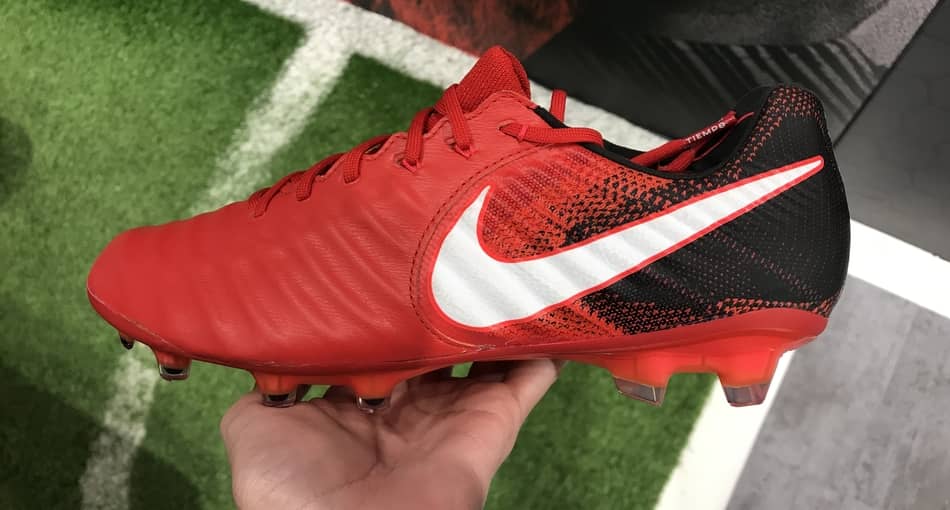
SG Boots
When it starts to rain, the field will get a lot softer obviously. You don’t have to be a genius to realize that FG boots are made for Firm Ground soccer fields. However, when it starts to rain they will not work as well as they would in a firm ground field.
It is not a bad idea to buy soft ground boots to play on rainy days. They are made specifically for this type of playing surface. They will penetrate the ground a lot more aggressively and deeper as the studs are made from metal and are longer, having a more natural feel to it and preventing you to slip around . Also, you will have more stability because usually SG boots have less and bigger studs, which suits better for a wet pitch than a lot of tiny studs like on FG soleplates.
Anti-clog boots
Earlier I talked about not wasting money on wet conditions control technologies. Well, Nike’s anti-clog technology is something worth taking a look.
Something that we all absolutely hate is when playing in a wet muddy pitch getting all the mud and grass stuck in our soleplate. Apart from being super annoying to clean, it makes you feel heavy and chunky when there is too much mud attached to the plate. The worst thing of this is that it might affect your performance.
You see, when your boot has accumulated too much mud underneath it, you will have less traction than you would with a clean plate, making you slip around the field. Boot will also be significantly heavier, making you get tired quickly and be slower.
Nike anti-clog technology is a new type of soleplate they have applied to almost all their SG models. Basically what makes anti clog special is that it is made from a material that, when wet, repels and prevents every material from sticking to it. You will not have to water your boots before a match because mud itself contains water (and its supposed to be raining, right?). So Nike turned water from something negative, to something positive.
Nike anti-clog technology is perfect to play in wet playing conditions, and its something that I would dare to say can give you just a LITTLE advantage over the people that doesn’t have it.
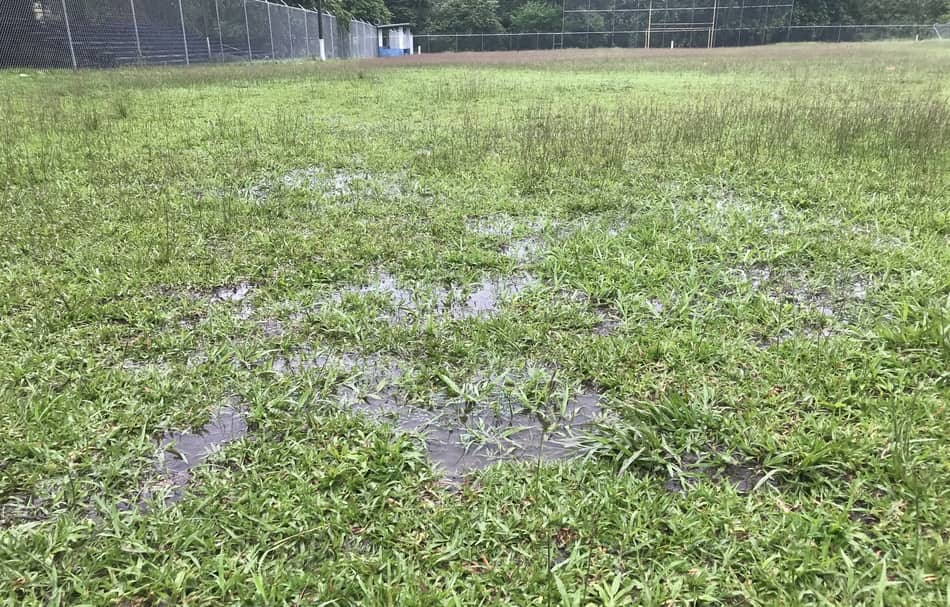
Get good protection
Because the game is now faster, players get faster and more aggressive with it. As I said above, when it rains players tend to slide tackle a lot more than they do in dry pitches. There is a higher risk of getting hit or injured. Make sure to have a good pair of shin guards and your protective gear on point. You can click here to read my recommended shin guards and here to see my recommended protective gear.
Extra pair of socks
Because socks are made of clothe they will absorb A LOT of water. It is the worst sensation in the world having to run around in a flooded pair of football boots. Not only that but you will probably get to a point well you’ll start to feel heavier and slower.
Having an extra pair of socks in your bag might be a great idea to change your first pair of socks that are completely wet, for brand new, totally dry ones. It will give you a sensation as if you were reborn.
Extra Clothe
Many times after training I had to go home all wet, get my car dirty, and everything. I remember one time I drove to my house only with my underwear, otherwise I would have made a mess all wet and muddy. Some people have to take the public transport back home and they are not aloud like this in the bus.
Be smart and always have this 2 things in your bag: Extra clothe (pants, under wear, t-shirt, socks) and a towel.
The best type of boot
There are two types of boots: synthetic and leather boots. Usually leather boots will swallow more water than a synthetic boot will. If you have the chance to choose, use your synthetic boots in rainy days. However, this doesn’t mean that wearing leather boots in a rainy day is a mistake. I actually like more wearing leather boots and would wear a pair of them even if its raining.
Get grippy boots
There will always be grippy boots and more smoothly surfaced boots. For raining conditions it would make more sense to have a more grippy surface boots, as well as in the soccer ball you are playing with. Not saying it will make you a better player, but it can actually make you feel more comfortable.
Or…. you could just practice more your ball control. If you have a bad technique, there is absolutely nothing you can do to make it better besides practicing. If you have an excellent ball control, you will do it as well in a pair of smooth upper boots as you would with a grip upper boot.
Clean your boots
Never leave your wet soccer boots in your bag after a rainy day. You have to clean them up correctly in order to ensure the durability of your boot. Pieces of mud and overall dirt can seriously shorten the life of your cleats.
What I do is that I take the hose of my backyard and clean the boots with it, getting all the mud off them. Then, I bring a bucket full of water and soap and immerse that boot in it, gently scrubbing the upper and the remaining dirt. I finally rinse the boot well to wash away all the soap.
Dry them correctly
It is important after a game to let your boots dry naturally. If you leave them wet inside your backpack, your cleats durability con also be in danger. Especially boots today that have a lot of flyknit and primeknit elements, that are actual pieces of clothe that can rot, it is necessary to let them dry at natural climate conditions (not inside a bag). Plus, they will smell horribly bad after you take them out.
After I wash them, I make newspaper balls and insert them inside the shoe so it drys completely in the inside. Be careful not to expose the boot to direct sunlight for too much time as it can seriously affect the boot construction overall.
Conclusion
Playing soccer in the rain is something completely different from playing in normal dry playing conditions. By using this tips, you can get accustomed to it faster and feel more comfortable when playing in this climate.
However, there is nothing in this list that can better your performance drastically. Each player’s success will be based on their own effort and ability. If your bad controlling the ball in the rain, don’t waste your money in unproven technologies and boots with grippy uppers. Instead, practice your ball control under this conditions and you’ll see better results.
Soccer is played with your brain more than your feet. Don’t complain about the wet pitch, rather see it as an advantage.

